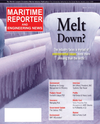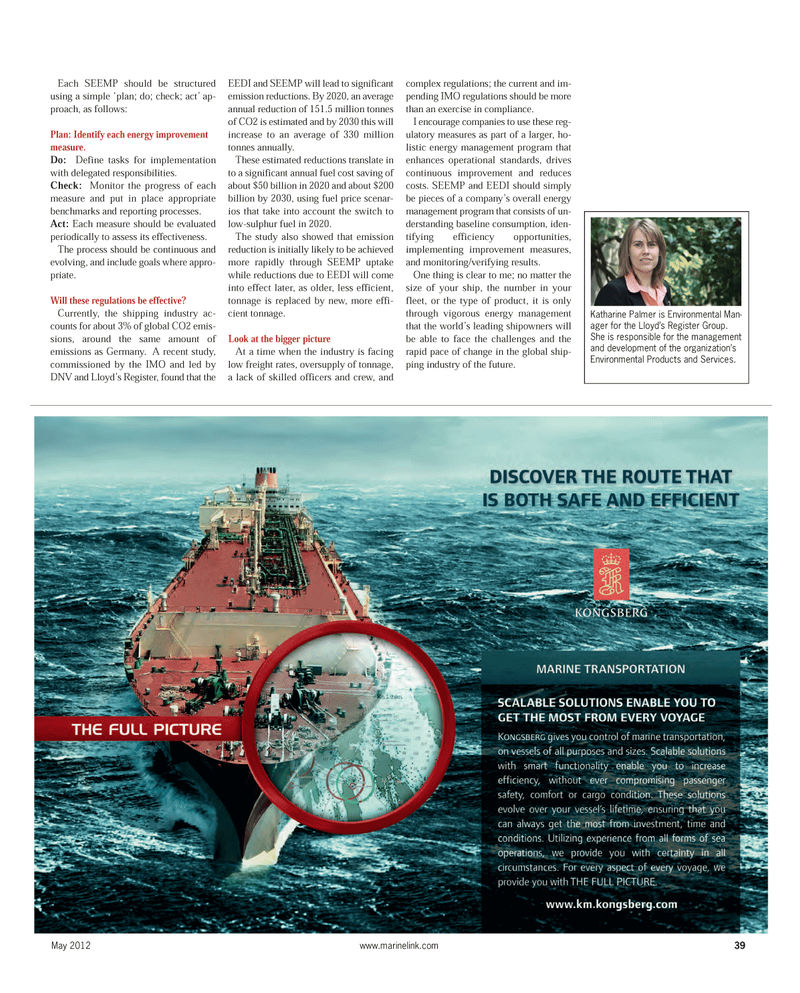
Page 39: of Maritime Reporter Magazine (May 2012)
The Green Ship Edition
Read this page in Pdf, Flash or Html5 edition of May 2012 Maritime Reporter Magazine
Each SEEMP should be structuredusing a simple ?plan; do; check; act? ap- proach, as follows: Plan: Identify each energy improvement measure. Do: Define tasks for implementation with delegated responsibilities. Check: Monitor the progress of eachmeasure and put in place appropriatebenchmarks and reporting processes. Act: Each measure should be evaluated periodically to assess its effectiveness. The process should be continuous andevolving, and include goals where appro- priate. Will these regulations be effective? Currently, the shipping industry ac- counts for about 3% of global CO2 emis-sions, around the same amount ofemissions as Germany. A recent study, commissioned by the IMO and led byDNV and Lloyd?s Register, found that the EEDI and SEEMP will lead to significant emission reductions. By 2020, an average annual reduction of 151.5 million tonnesof CO2 is estimated and by 2030 this willincrease to an average of 330 million tonnes annually. These estimated reductions translate into a significant annual fuel cost saving of about $50 billion in 2020 and about $200billion by 2030, using fuel price scenar- ios that take into account the switch to low-sulphur fuel in 2020. The study also showed that emission reduction is initially likely to be achieved more rapidly through SEEMP uptake while reductions due to EEDI will comeinto effect later, as older, less efficient, tonnage is replaced by new, more effi- cient tonnage. Look at the bigger picture At a time when the industry is facing low freight rates, oversupply of tonnage, a lack of skilled officers and crew, and complex regulations; the current and im- pending IMO regulations should be more than an exercise in compliance. I encourage companies to use these reg- ulatory measures as part of a larger, ho- listic energy management program that enhances operational standards, drives continuous improvement and reduces costs. SEEMP and EEDI should simplybe pieces of a company?s overall energy management program that consists of un-derstanding baseline consumption, iden-tifying efficiency opportunities, implementing improvement measures, and monitoring/verifying results. One thing is clear to me; no matter thesize of your ship, the number in yourfleet, or the type of product, it is onlythrough vigorous energy management that the world?s leading shipowners will be able to face the challenges and the rapid pace of change in the global ship-ping industry of the future.May 2012www.marinelink.com 39Katharine Palmer is Environmental Man- ager for the Lloyd?s Register Group. She is responsible for the management and development of the organization?s Environmental Products and Services. MR May 12 # 5 (34-41):MR Template 5/7/2012 2:47 PM Page 39

 38
38

 40
40
